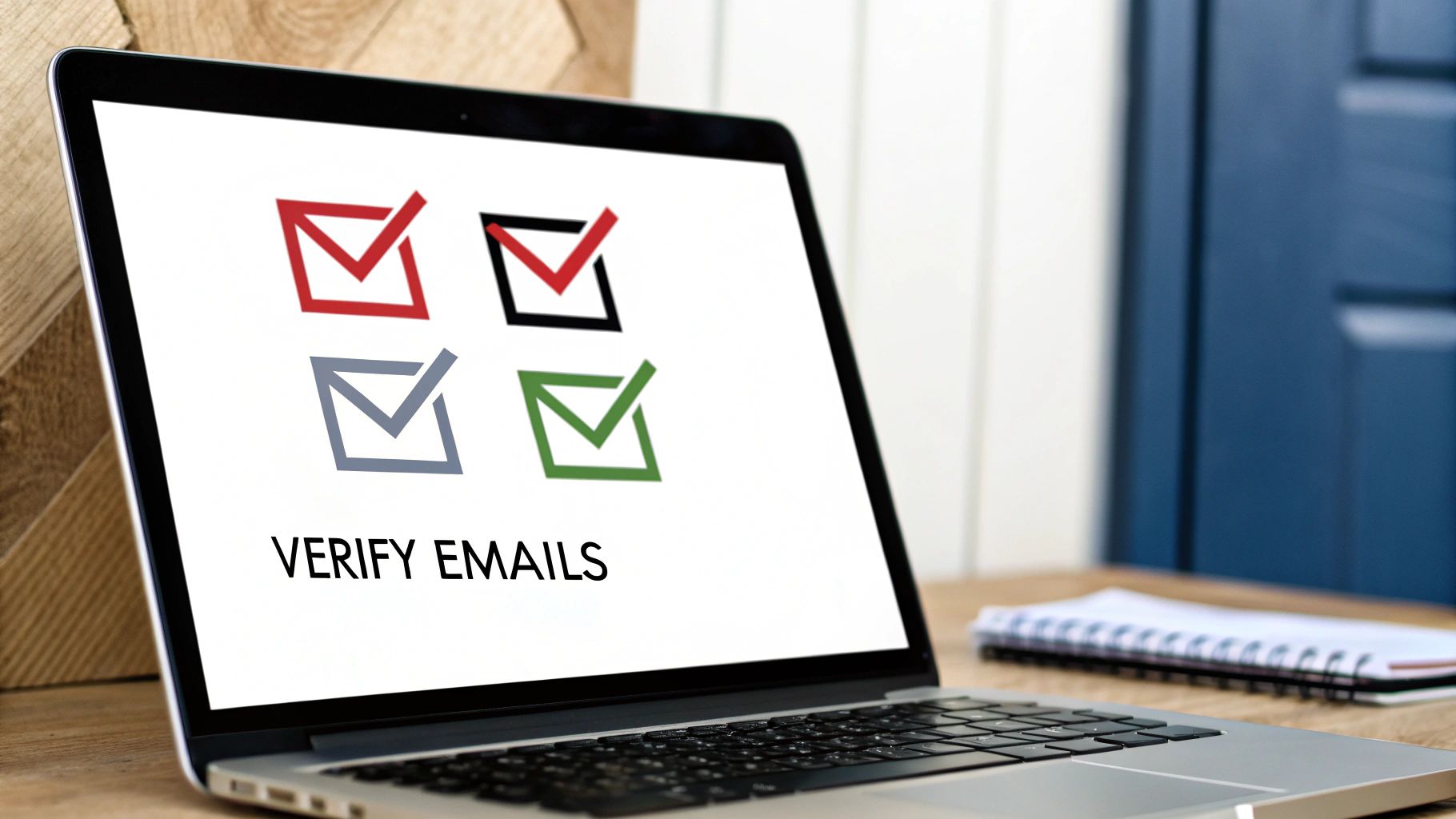Understanding Email Verification Tools and Their Market Impact
Email verification has become essential for any business doing email marketing. Getting emails to actual users – rather than invalid addresses – directly affects how well your campaigns perform and how others view your brand. Let’s look at the key ways email verification shapes your business results.
How Email Verification Impacts Your Business
Clean email lists mean better delivery to inboxes. By removing fake or inactive addresses, verification tools help ensure your messages actually reach real people instead of bouncing back or getting caught in spam filters. For instance, a verified list can boost delivery rates from 70% to over 95%.
Your sender reputation also benefits significantly. Think of it like a credit score for email – too many bounced messages can tank your reputation and make it nearly impossible to reach inboxes. Email verification acts as a shield, protecting your sender score by maintaining clean lists of active subscribers.
There’s a clear financial advantage too. Sending emails costs money, whether through staff time or email service fees. Verification tools eliminate wasted spending on bad addresses, focusing your budget on real potential customers. This leads to better returns on your email marketing investment.
The benefits compound when it comes to engagement. Messages that land in actual inboxes get opened, clicked, and drive results. Clean lists routinely see 20-30% higher engagement rates across key metrics like opens and clicks. More engagement means more leads and sales.
This growing focus on list quality and campaign performance is driving major growth in email verification tools. The market hit $124.95 million in 2023 and is on track to reach $232.44 million by 2031, growing at 8.9% annually. These numbers show how seriously businesses take data quality and email effectiveness. Learn more about the email verification market growth and trends
The Future of Email Verification
Email verification keeps getting smarter. New tools use AI and machine learning to check addresses faster and more thoroughly than ever before. They can spot patterns and problems that basic verification misses. For businesses, this means cleaner lists, better targeting, and ultimately stronger results from email campaigns. Staying current with these advances helps maintain an edge in reaching and engaging customers effectively.
Market Leaders and Their Game-Changing Features
Email verification tools continue to improve as providers develop better ways to validate addresses. Companies now have many options to consider, from basic syntax checking to advanced spam trap detection. The key is understanding which features matter most for your specific email marketing needs.
Exploring Key Players in Email Verification
A few major companies dominate the email verification market today. Mailgun leads with an impressive 67.36% market share, while DeBounce holds 31.98% and NeverBounce maintains 0.26%. Other notable providers include Melissa, Snovio, Xverify, and Emailable. Each offers core services like address verification and list cleaning, along with specialized features to help improve email deliverability. For more details about market share, check out this comprehensive market analysis.
This healthy competition drives providers to keep developing better solutions. As a result, businesses can find tools that match their exact needs, whether that’s processing large lists or checking addresses in real-time.
Evaluating Essential Features for Optimal Performance
When selecting an email verification service, it’s important to match the features to your goals. Some businesses need to clean existing databases, while others want to prevent bad addresses from being added in the first place.
- Bulk Verification: Perfect for cleaning large lists all at once. These tools can process thousands of addresses simultaneously to find invalid or risky emails that could hurt your sender reputation.
- Real-Time Verification: Checks email addresses as people enter them on forms. This stops bad addresses before they enter your database and helps maintain list quality from day one.
- Spam Trap Detection: Finds and removes dangerous spam trap addresses that can get you blacklisted. Hitting even one spam trap can seriously damage your ability to reach inboxes.
- Syntax Validation: Catches common typos and formatting mistakes in email addresses. This basic but essential check helps maintain clean data from the start.
The Power of Integrations
Good integrations make email verification much more efficient. When your verification tool connects smoothly with your email marketing platform or CRM, list cleaning becomes automatic instead of manual. Many providers also offer APIs so developers can build custom verification flows for specific needs.
Essential Features That Drive Real Results
The best email verification tools do more than just check if addresses exist – they offer key features that work together to improve your email marketing results. Let’s explore the most important capabilities and how they help create successful email campaigns that connect with your audience.
Must-Have Features for Effective Email Verification
When choosing an email verification tool, focus on features that match your specific needs. Some excel at cleaning existing lists while others prevent bad addresses from getting in. Here are the essential features to look for:
- Bulk Email Verification: Perfect for processing large email lists all at once. This feature finds invalid, inactive and problematic addresses that could hurt your sender reputation. If you have an established email list, bulk verification should be your first step.
- Real-Time Email Verification: Checks addresses as people enter them on your forms. For example, when someone signs up for your newsletter, the tool instantly validates their email. This stops bad addresses from getting into your database and keeps your data clean from day one.
- Spam Trap Detection: Spam traps are addresses used to catch senders with poor list practices. Just one spam trap can seriously damage your reputation with email providers. Good verification tools spot these traps before they cause problems.
- Syntax Validation: Catches basic errors like typos and wrong formatting. While simple, this feature provides critical protection against obvious mistakes that lead to bounces. Think of it as your first line of defense for data quality.
Advanced Features to Boost Performance
The best tools also include sophisticated features that give you deeper insights into your email list:
- Email Deliverability Testing: Shows how likely your emails are to reach inboxes by testing with different email providers. This helps you spot and fix potential problems before sending campaigns. You can then adjust your content and sending practices for better results.
- Catch-All Email Detection: Identifies servers that accept all emails sent to their domain, whether addresses exist or not. This matters because catch-all addresses can hide invalid ones. B2B companies especially need this feature to maintain accurate lists.
- Role-Based Email Detection: Spots addresses tied to departments or roles like [email protected]. This helps you segment your audience and send relevant content to the right people. For B2B outreach, knowing who you’re really talking to makes a big difference.
Choose features that fit your goals and budget. The right tool will help you build a cleaner list, protect your sender reputation, and get better results from your email marketing. Focus on what matters most for your business and start there.
Making Smart Investment Decisions: Pricing and ROI
Smart email verification tool selection requires careful analysis of both costs and potential business value. Before investing, you’ll want to understand the various pricing options available and evaluate how these tools can improve your email marketing results over time. Let’s explore how to make an informed choice.
Understanding Pricing Models
Email verification services typically offer two main pricing approaches: pay-as-you-go and subscription-based plans. With pay-as-you-go, you buy credits to verify a set number of emails. Subscription plans provide monthly verification allowances. For example, MailerCheck offers a free tier with basic features plus credit purchases for additional verifications. This gives you flexibility to scale up or down based on your needs.
Costs can vary significantly between providers. EmailListVerify charges just $0.004 per email for pay-as-you-go, while Emailable subscriptions start at $38 monthly. Services like ZeroBounce and NeverBounce give you both options. Take time to compare pricing alongside the specific features each tool provides.
Calculating the ROI of Email Verification
The real value of verification tools comes from their impact on key metrics. Most importantly, they improve deliverability – helping more of your emails reach inboxes rather than spam folders. This directly affects your sender reputation, which email providers use to determine if they’ll deliver your messages. Poor sender reputation can seriously hurt your campaign performance.
You’ll also save money by reducing bounce rates. Fewer bounces means you’re not wasting resources sending to invalid addresses. Plus, clean lists lead to better engagement, which can increase customer lifetime value over time as more subscribers stay active and convert.
Maximizing Your Investment
To get the most from your verification tool, look closely at features, pricing, and how well it works with your current marketing systems. Many providers offer discounts for high-volume users – both EmailListVerify and NeverBounce provide better rates as your usage increases. Don’t hesitate to ask about volume pricing if you have a large list.
Pay attention to advanced features like real-time verification, spam trap detection, and syntax checking. These proactive tools help maintain list quality over time by catching problems before they impact deliverability. By choosing a verification service with robust capabilities, you can improve both the immediate and long-term results of your email marketing efforts.
Seamless Integration: From Selection to Success
Adding an email verification tool to your existing systems requires careful thought and planning to see real benefits. Think of it like adding new equipment to an assembly line – it needs to work smoothly with your current setup to truly improve efficiency. The key is methodical implementation through proper planning, team preparation, and consistent fine-tuning.
Planning Your Integration Strategy
Start by mapping out how email addresses flow through your current marketing processes. Identify where addresses enter your system and how you manage your lists. This will help determine the best integration approach. For instance, if your team primarily uses a CRM system, focus on tools offering direct CRM connections to minimize disruption and manual work.
Methods of Integration
Top email verification tools typically provide several ways to connect with your systems:
- API Integration: The most flexible option, APIs let developers connect verification directly into your systems for custom workflows and real-time checks during signups. EmailAddress.ai offers a powerful API for smooth data flow.
- Plugin Integrations: Many tools have ready-made plugins for common platforms like WordPress, Shopify, and major email marketing services. These provide quick setup without coding.
- List Upload: The simplest approach involves uploading email lists as CSV or TXT files for one-time cleaning. While less automated, this works well for initial cleanup and periodic maintenance.
Team Training and Workflow Optimization
New tools only deliver value when teams know how to use them properly. Make sure your staff understands how the verification system works, its benefits, and how it fits into their daily tasks. For example, teach your marketing team to use real-time verification when capturing leads to stop bad data before it enters your system.
Testing and Refinement
Once your email verification tool is running, track key metrics closely. Monitor bounce rates, deliverability scores, and sender reputation to measure the impact. Use this data to identify what’s working and what needs adjustment. Test different settings and integration methods regularly to improve accuracy and efficiency. With ongoing refinement, your email verification tool will become an essential part of your marketing operations and deliver consistently better results.
Measuring Impact: Performance Metrics That Matter
The success of your email verification tool needs to be measured through clear metrics and consistent monitoring. Let’s explore the key performance indicators (KPIs) that show how verification is improving your email marketing and how to track them effectively.
Key Metrics for Tracking Email Verification Success
These essential metrics reveal both immediate and long-term improvements from maintaining a clean email list:
- Bounce Rate: Measures emails that fail to reach recipients’ inboxes. For example, seeing your bounce rate drop from 10% to 2% after implementing verification shows the tool is effectively removing invalid addresses.
- Deliverability Rate: Shows the percentage of emails landing in inboxes successfully. Better deliverability means more recipients see and engage with your messages.
- Spam Complaint Rate: Tracks how often people mark your emails as spam. Lower complaint rates indicate improved sender reputation and list quality.
- Email Open Rates: While subject lines and content affect opens, better deliverability helps more emails reach inboxes instead of spam folders. This metric shows how well you’re connecting with your audience.
- Click-Through Rate (CTR): Similar to open rates, CTR typically rises with improved deliverability as more people see your emails. This shows if your content resonates with readers.
Building a Performance Dashboard
To monitor these metrics effectively, set up a dashboard giving you a clear view of your email marketing performance. Most email platforms include built-in analytics, or you can create custom dashboards using spreadsheets or analytics tools. Focus on visualizing the key metrics above to spot trends over time.
Communicating Value to Stakeholders
Share the positive impact of email verification with stakeholders through clear performance reports. Use your dashboard to highlight improvements in bounce rates, deliverability, and engagement metrics. Show how lower bounce rates reduce costs and how better open rates and CTRs drive business goals like leads and sales.
Regular monitoring helps you optimize your approach, adapt to changes, and keep improving your email marketing ROI. The data tells you what’s working and where to focus your efforts.
Want to see how advanced email verification can boost your results? EmailAddress.ai provides accurate, real-time verification to improve deliverability and campaign performance. Start your free trial today.





